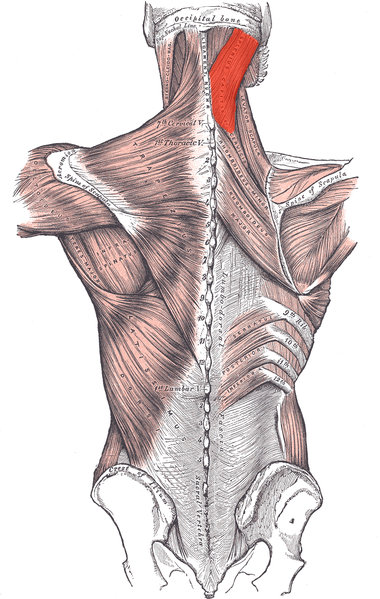Splenius Capitis: Difference between revisions
mNo edit summary |
m (deleted pubmed) |
||
| Line 8: | Line 8: | ||
== Description<br> == | == Description<br> == | ||
Musculus splenius capitis is one of the deep (or intrinsic) muscles of the back. It is a broad | Musculus splenius capitis is one of the deep (or intrinsic) muscles of the back. It is a broad strap-like muscle in the back of the neck. Deep to Sternocleidomastoid at the mastoid process.<ref name="gray">Gray's Anatomy of Human Body, Bartleby.com edition. New York: 2000.fckLRhttp://www.bartleby.com/107/115.html</ref> <br> | ||
| Line 45: | Line 45: | ||
It also assists in supporting the head in the erect position<ref name="gray" /> | It also assists in supporting the head in the erect position<ref name="gray" /> | ||
== References == | == References == | ||
Revision as of 17:54, 6 June 2018
Original Editor - Venus Pagare
Top Contributors - Rachel Vogel, Lucinda hampton, Oyemi Sillo, Venus Pagare, Ahmed Nasr, WikiSysop, Kim Jackson and Tarina van der Stockt
Description
[edit | edit source]
Musculus splenius capitis is one of the deep (or intrinsic) muscles of the back. It is a broad strap-like muscle in the back of the neck. Deep to Sternocleidomastoid at the mastoid process.[1]
Origin[edit | edit source]
Lower half of Nuchal ligament (C4-C6) and spinous process of C7-T3[2][3]
Insertion[edit | edit source]
Superior nuchal line, Mastoid process of temporal bone, and rough surface adjoining occipital bone[2][3]
Nerve Supply[edit | edit source]
Dorsal ramus of spinal nerves C3-C6[2]
Blood Supply[edit | edit source]
Muscular branches of the occipital artery from the external carotid artery. [2]
Action[edit | edit source]
Acting bilaterally: extension of the head and neck;
Acting unilaterally: lateral flexion of the head and neck and rotation the head to the same side. [3]
Function[edit | edit source]
It also assists in supporting the head in the erect position[1]







